Content
Regardless of the core business problem you seek to solve through building high-quality software products, there are key milestones you come across along the way. From initial software product ideation to final deployment and post-release support, your software product’s success depends on how you build this software product development process.
In this article, we’d like to share RewiSoft’s practical insights and best practices with companies who are seeking advice on how to develop software products correctly. Among the wide variety of software product development approaches, activities, and procedures, you must decide what works best for your unique project.
After reading this blog post, you will:
- Understand what methods suit your goals
- Explore core software product development steps not to be missed
- Realize how to establish the right workflow
- Learn when, where and what you need to do to achieve the expected project outcomes
What is Software Product Development?
Software product development can describe the process of developing a new product, upgrading an existing product, or improving the development process. The primary outcome of developing a software product is a deployed and ready-to-use software product that meets specific business and market needs. Software product development means converting an initial product idea into a functional product.
In turn, the software product development process is an iterative logical process with many short milestones required to develop a fully-functional software solution from ideation to product launch.
The primary role of the software development life cycle is to deliver a high-quality and functional product that meets software quality standards and your unique business goals. The process of creating a software product helps build high-quality software and track progress at every short iteration. From ideation to product release, SDLC enables you to understand where problems are rooted, fix them on time, and ensure that every new release rolls out successfully.
To make this process efficient and result-oriented, you must apply the best practices, methodologies, tools, and collaboration models that match your project. Also, one more challenge here is the need to choose a well-elaborated software development strategy that will meet project requirements, deadlines, and budget.
Before you learn how to do this, there are specific differences between custom software and off-the-shelf solutions you need to know to organize the product development process right.
Let’s have an in-depth look at the table below.
How to Develop a Software Product in 8 Key Steps
Proper organization of the software development process is the root cause of effective teamwork and successful product releases. After we’ve discussed all the essential nuances and definitions, let’s visualize and describe how this process works in practice.
Step 1. Initial discovery & research
By getting started with an initial product idea, software development teams can slightly understand the essence of the future software product. To get an overall product’s perception in terms of technical, economic, and operational feasibility, the teams organize brainstorming sessions and perform initial discovery and research.
This stage helps create the project’s roadmap, validate the market idea, and formalize the technical requirements for the product. Before embarking on the journey of creating a software product, we can highlight the key activities and results that you must achieve at the end of each stage:
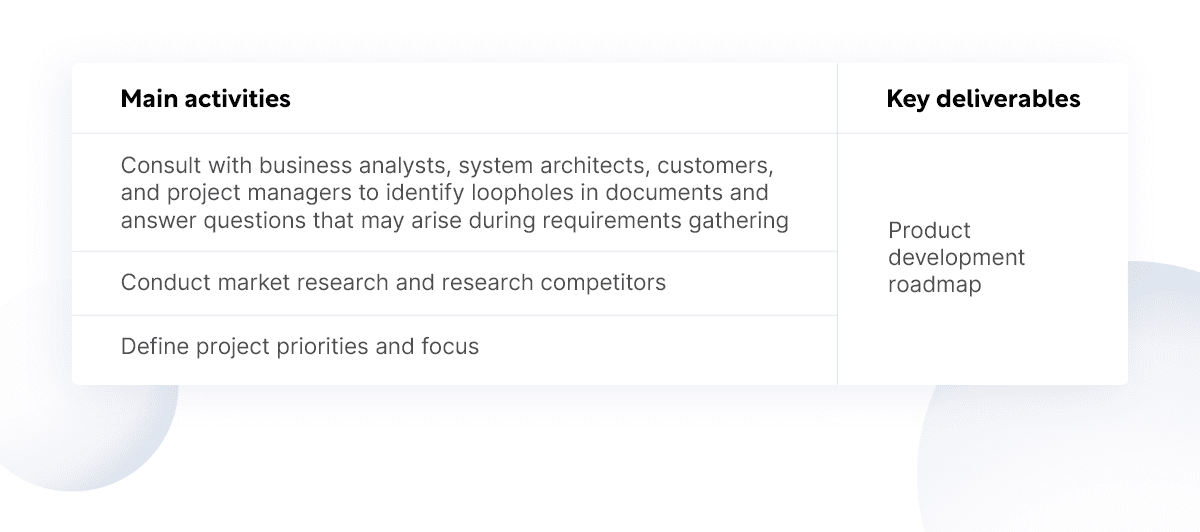

Initial discovery & research
Step 2. Project planning & stakeholder workshops
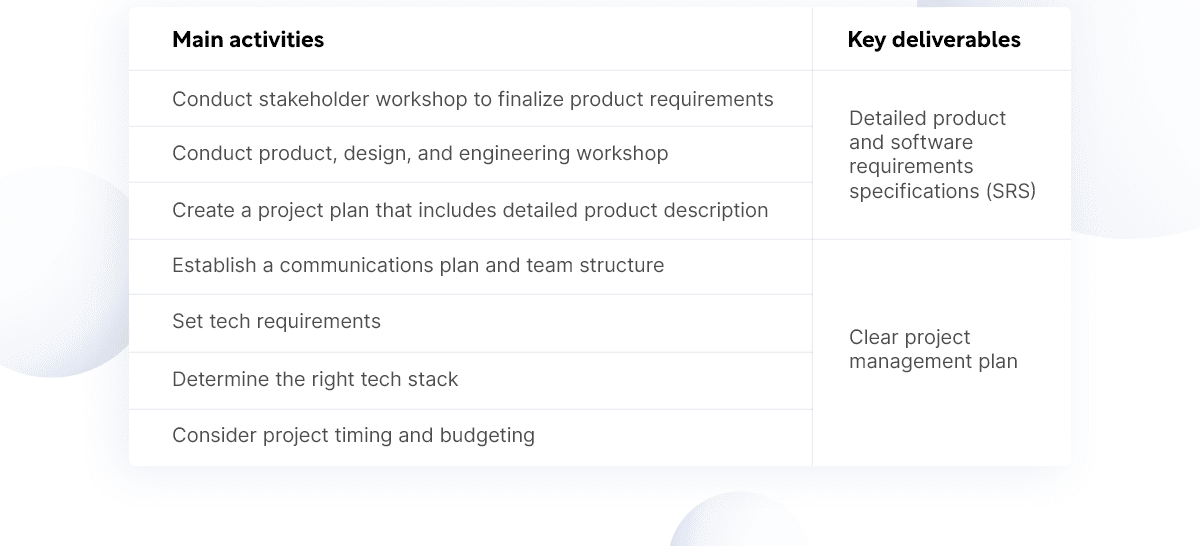

Project planning & stakeholder workshops
Step 3. Choose software product development methodology
At this stage, you should choose a software product development methodology. There are 4 methodologies that may suit you for software product development: agile development methodology, waterfall development methodology, scrum methodology and mixed product development methodology. You will receive a more detailed comparison a little later in the article.


Choose software product development methodology
Step 4. Product architecture design, wireframing, and prototyping
Once the project plan is ready, it’s time to design and develop the software product flow and functionality. Prototyping wireframes is essential to set users’ interactions with the software product. It can also help get user feedback early on and test first design mockups. UX/UI step is the core milestone ensuring a smooth and user-friendly experience and seamless interaction with developers. Skipping it can affect your final software product’s quality and value.
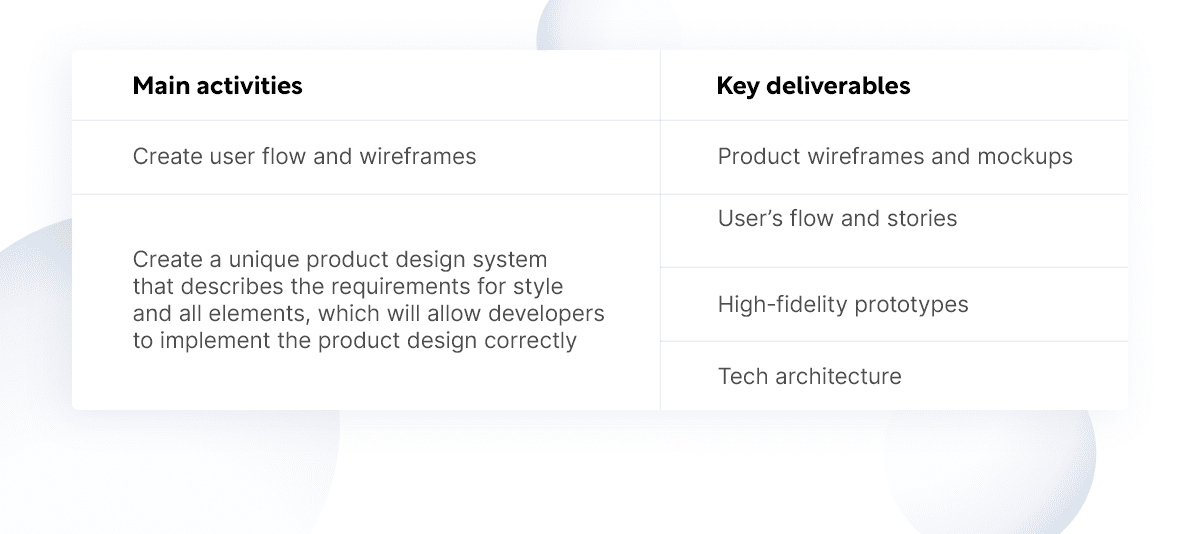

Product architecture design, wireframing, and prototyping
Step 5. Software product development
During this step, developers begin writing code complying with product and SRS documentation. Depending on the type of methodology and defined scope of work, developers implement features step by step. Software product development consists of two main stages: front-end and back-end development. Achieving high-functioning software requires both front-end and back-end developers to work in tandem.
Front-end specialists focus on the user experience through the interface, while back-end engineers create infrastructure for it to run seamlessly – from servers and applications that deliver information efficiently behind the scenes. Together they form an essential partnership with opposite concerns but the single goal of creating robust systems users will love interacting with.
At RewiSoft, we adhere to Agile or mixed software product development to ensure timely risk mitigation and requirements compliance.
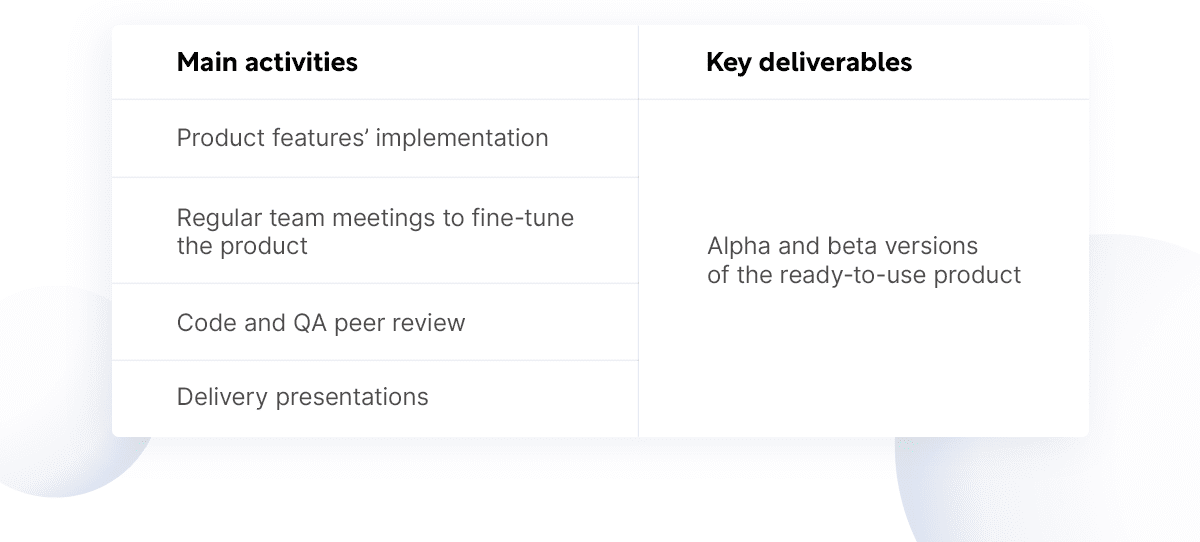

Software product development
Step 6. Testing
The testing part is integral to the software product development process to ensure a flawless and high-quality experience before the product goes public. The sooner errors are identified, the easier and cheaper it will be to fix them. It’s better to apply both manual and automated testing to ensure high software product quality and eliminate as many risks as possible.


Testing
Step 7. Deployment
We adhere to the gradual deployment process to deploy the software product sequentially to avoid incorrect system operation. In this way, your team will collect early user feedback, understand possible software product vulnerabilities and rework them until the product is fully integrated.
The RewiSoft team deploys the final solution to production and performs a series of tasks to make sure the product is ready for use by end users.
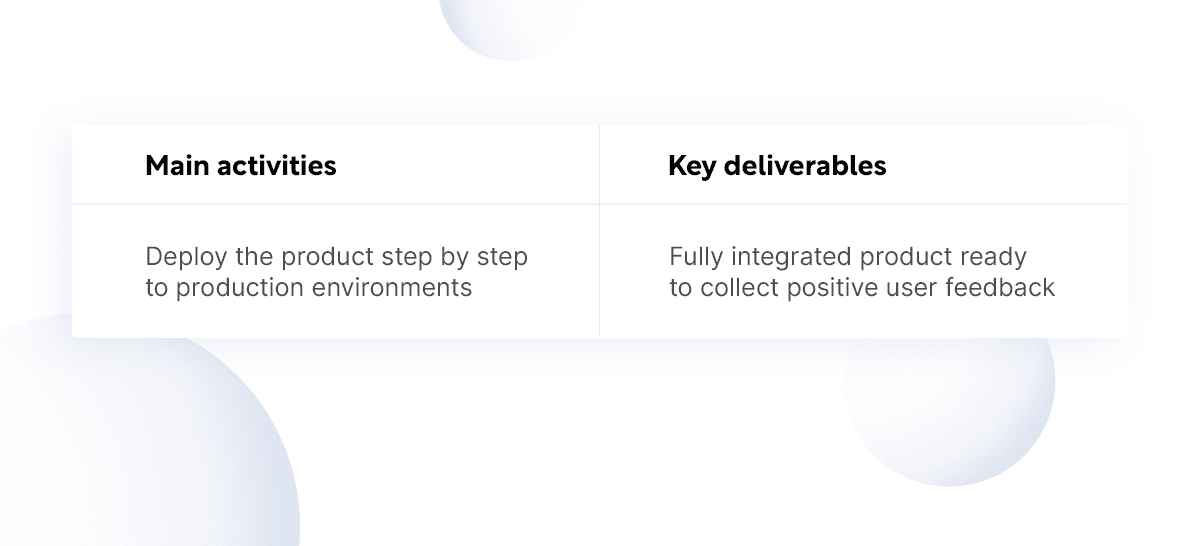

Deployment
Step 8. Maintenance
The final stage of the software development process entails regular software product upgrades. The main goal of this stage is to maintain the product’s robust functionality, fix problems that arise, improve performance, and similar.
The RewiSoft team offers post-release support to our customers to foster the product’s successful results, satisfy users and drive innovation.
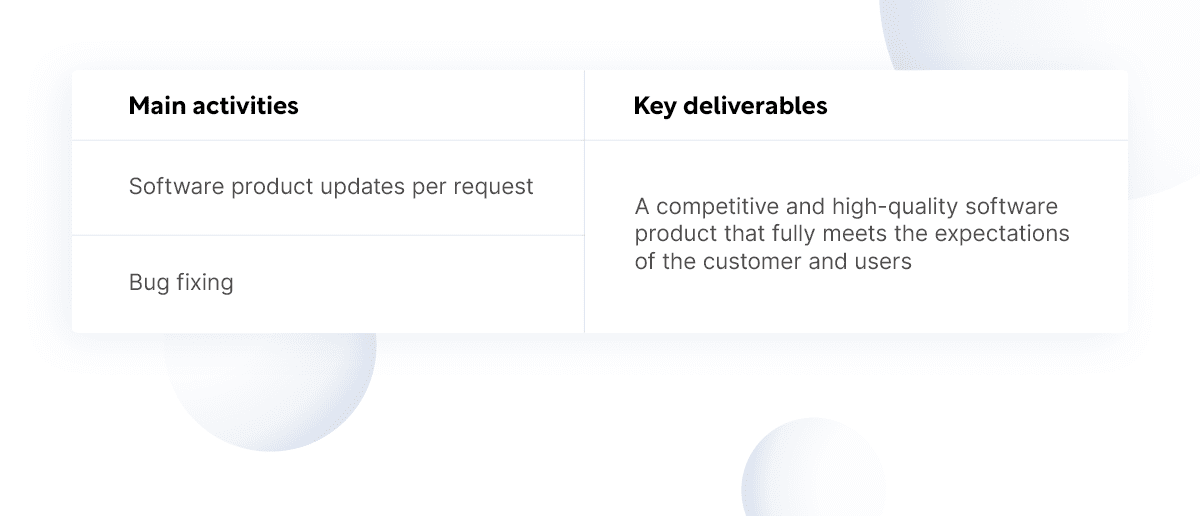

Maintenance
Go through all steps of the software development process with RewiSoft’s professionals. Just share your product idea, and we’ll take care of the rest.
How to develop a software product with RewiSoft?
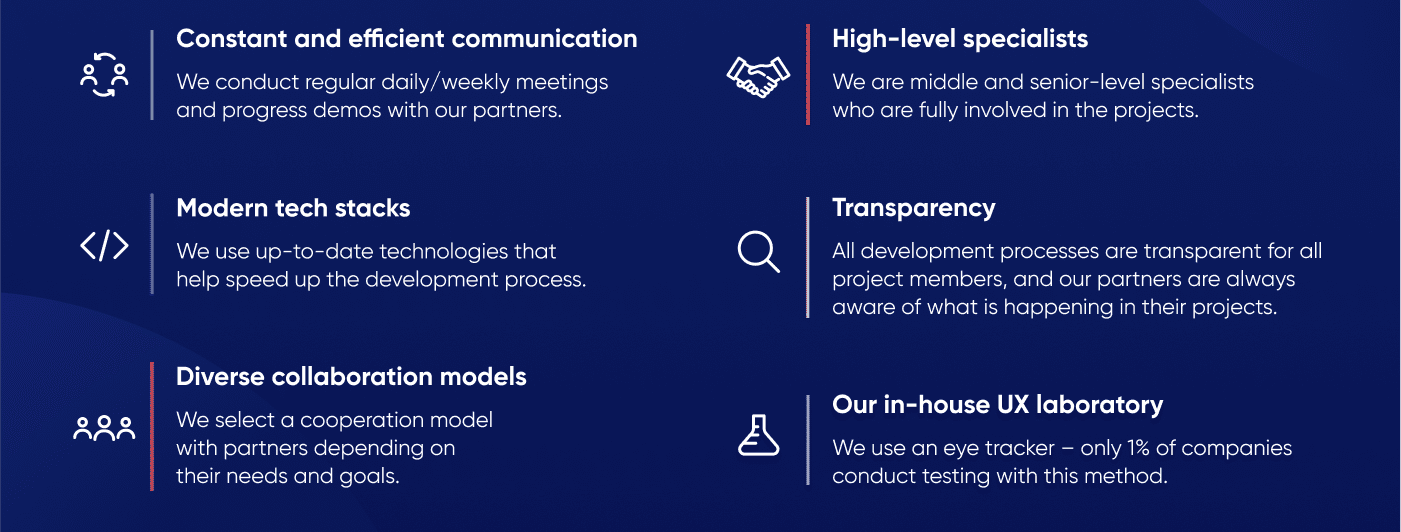

Why choose RewiSoft
Another direction to look for a professional software development team is RewiSoft. Based on your product goals and business needs, we can develop a project roadmap to fit your budget and deadlines.
Thanks to our experience in developing projects for various industries, we have a well-established workflow and offer our clients a flexible cooperation model, best tools, and technologies.
Don’t miss the opportunity to get acquainted with recent projects we have worked on and the industries for which we develop software products and solutions.
- Education (Miestro – a learning management platform that helps experts create educational courses and reach a wider audience of learners to provide high-quality online training)
- FinTech (Cardeo – a simple and convenient application for managing credit cards)
- E-commerce (E-wish – the UK’s multifaceted marketplace)
- Healthcare (Theraheal – an AI-powered well-being application that helps improve mental, emotional, and physical health)
- SaaS (MeetAlfred – sales enablement software for LinkedIn, Email, and Twitter)
- Real Estate (Tigra – a proptech solution that helps solve property-related questions with an all-in-one system)
RewiSoft team can provide you with the following software product development services:
- Enterprise software development. We can design and develop any kind of software, namely CRM, SCM, ERP, BPM systems and others.
- Software development outsourcing. We differ from other companies that provide software development outsourcing services in that we perfectly combine unique talents, broad expertise, deep knowledge and individual approach.
- Software product development. Our software product development services assist in the creation of commercially viable software for corporate customers or individual ones.
- End-to-end software development. We provide end-to-end software development services in accordance with your product concept and budget.
- Software QA. Taking into account all your requirements, we will make sure that your software works like a Swiss watch.
- Application development services. RewiSoft team can design and develop applications of any size and complexity.
Having successfully completed over 160 projects in a couple of years, our team has been ranked as:
Top Development & IT Companies in Ukraine by Clutch
- Top 3 Web Developers in Munich by Clutch
- Top 1 Software Developers in UAE by Clutch
- Top 10 Design Agencies by the Manifest.
Our software experts use the following technologies to build and upgrade software products:


Software development technologies
So, if you need:
- A proven track record of company success
- High-level and seasoned specialists
- Transparent software product development workflow
- Efficient team management
- Modern tech stack knowledge
- Flexible contract types (fixed price, time and material, dedicated team)
- Timely release of high-quality software product
Contact us to get a dedicated software development team as soon as possible.
Who Needs Software Product Development?
From the software business perspective, product development is the core company process. Often, this process requires external resource involvement and specific experts without sacrificing the deadlines and budget allocated.
Small-medium businesses (SMBs)
In the case of SMBs, several ongoing software development projects require constant attention and support. Therefore, such companies can often experience time and financial constraints. So they need to hire professional software development teams who follow a mature software product development process.
This way, SMBs can:
- Avoid the hassle associated with team recruitment and onboarding
- Reduce hiring costs
- Optimize team workload
- Acquire needed talent
- Ensure jobs are done on time and of the required quality
Enterprise-level companies
If you have a large business, you may already have established workflows; you adhere to your software development practices; you have enough specialists to work on different projects.
A possible cause for concern is the massive pool of short-term tasks revolving around big and long-term projects. Or often, a highly specialized expert in a particular technology is required.
Thus, it is wise to delegate these tasks to remote teams without wasting internal resources. The only aspect is that the remote team’s workflow should match your style of project management and have the required team composition.
The good news is endless opportunities to hire an offshore team to meet your business needs per your expectations directly.
When Do You Need Software Product Development?
You may have different business needs if you want to meet the market demand by developing successful software products. Let’s see what business inquiries might be a prerequisite for creating a software product and what your company can gain.
Higher profitability
There are more chances to increase company profits by successfully deploying each new feature at the end of the SDLC iteration. When done right, the software development process ensures the final product’s quality, robust functionality, and efficiency. This lead to higher business profitability and quicker return on investment.
Meeting specific business needs
You must weigh the pros and cons before purchasing off-the-shelf solutions when you want to meet a particular business need with a software product. It is often difficult to find a one-fit solution. So, if you choose to develop custom software products or solutions, you’ll be able to address exact business needs. In addition, custom software adapts flexibly to changing technology trends. Thus, custom software is well suited for businesses in the long run.
Advanced features required
Considering companies with complex projects requiring complex features is the reason to “vote” for custom software development. With custom development, you are more likely to meet ever-changing market demands and remain competitive.
Business scaling
When you need more space to scale and grow your business, software development is your tool to make it happen. However, ready-made solutions encompass only the features your business needs at the moment. To avoid overheads, choose to build custom software products. In such a way, you’ll be able to implement new features and grow your product whenever you need.
Seamless integration with an existing ecosystem
Custom software is a worthwhile solution to ensure seamless integration with the existing ecosystem. The chances of integration issues are significantly lower compared to ready-made platforms.
Enhanced reliability
Software products’ data should be highly secured with high-level security measures. Depending on the industry, you must adhere to specific standards and regulatory compliance.
For example,
- For the fintech industry: PCI DSS (Payment Card Industry Data Security Standard) and OWASP(Open Web Application Security Project)
- For the healthcare industry: regulatory compliance (HIPAA, PIPEDA, GDPR, and FDA)
- ISO 27001 certification (information security management system according to international standards)
These requirements help prevent data breaches, cyber-attacks, and other security flaws. These standards also protect sensitive customer data. Besides, while creating a software product, you should ensure your team prioritizes the security level with an end-to-end framework that includes risk modeling, vulnerability, and security policies.
Custom Software Product Development Vs. Ready-Made One
To invest wisely, let’s review the validation criteria and look at the main differences between custom software products and a ready-made solution.
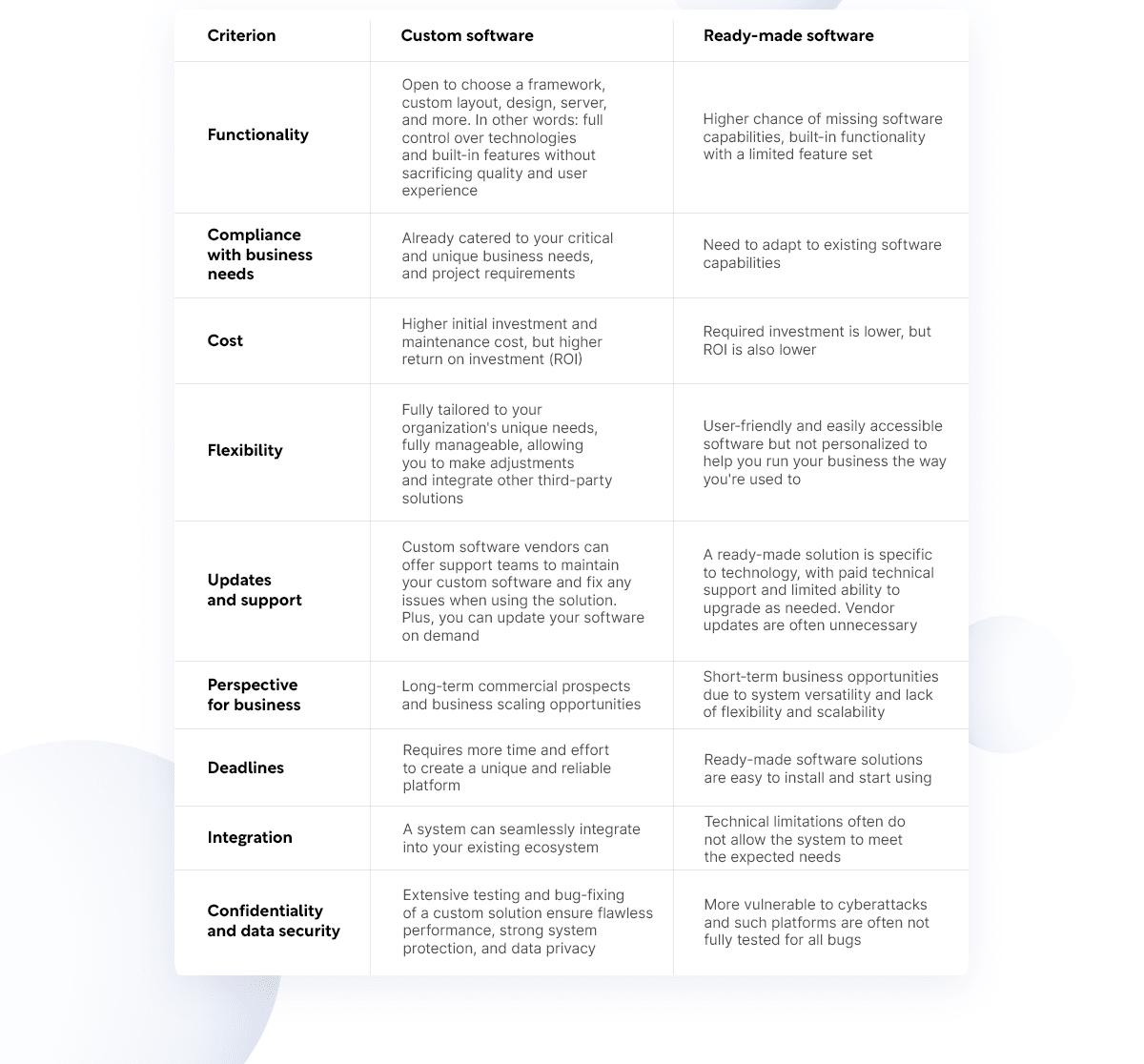

Custom Software Product Development Vs. Ready-Made One
For startups, we have an insightful guide to the critical aspects of custom software development you need to know to make the most out of this process.
How to Develop a Software Product With the Right Methodology?
To avoid scattering among numerous approaches and SDLC models, you’ll need to thoroughly analyze the market, users and plan your software product development process right. For this purpose, it is crucial to choose the best software development methodology corresponding to your company’s style and core goals. Let’s briefly discuss the differences between the most popular models and see which projects these models are best suited for.
Agile development methodology
In response to the changing priorities of the software development industry and fluctuating market demands, software companies emphasize flexibility in the development process. Agile uses an iterative approach that allows development teams to be more resilient to changes that inevitably occur during the project.
Agile employs an iterative and incremental process. It provides short product development cycles in the form of sprints that last 1-4 weeks. The team evaluates the completed scope of work and defines new goals to deliver release-ready products at the end of each cycle.
Let’s summarize the pros and cons of Agile software development in the form of a table:


Agile development methodology
Waterfall development methodology
Traditional Waterfall methodology entails a linear-sequential life cycle model that governs project management.
In the Waterfall environment, the development process has a strict, orderly structure. It means the team proceeds with the next task only when the previous one is done. In other words, the software development process is divided into such stages:
- Discovery
- Design
- Development
- Testing
- Deployment
- Maintenance
The pros and cons of Waterfall software development and the projects this model works best:
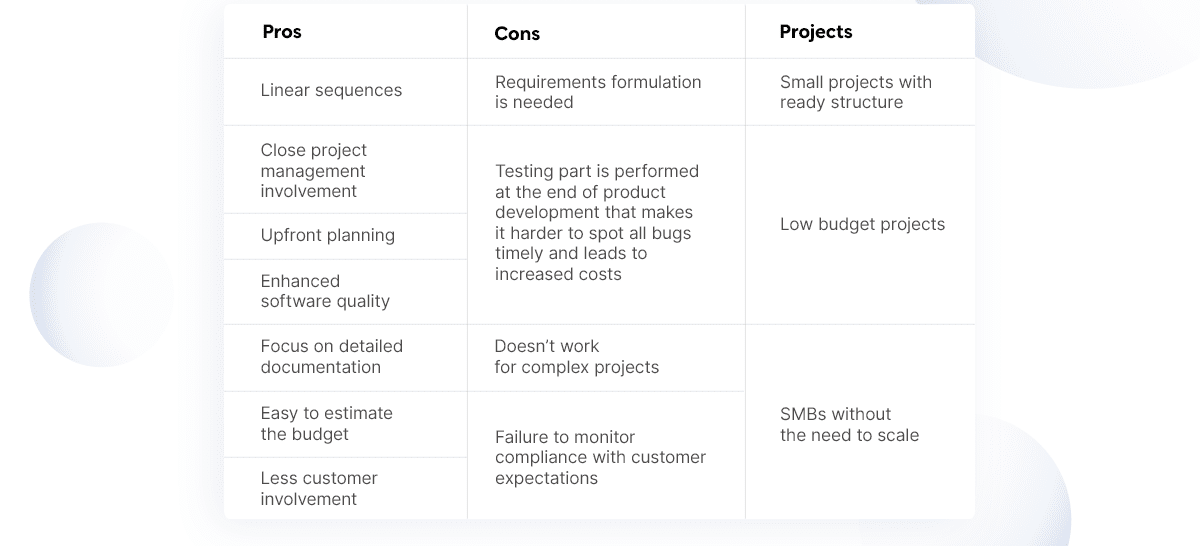

Waterfall development methodology
Scrum methodology
Scrum methodology is an Agile-adapted methodology distinguished by special flexibility. This model implies an iterative approach to project management with direct customer involvement. The work splits into sprints, where the project and delivery managers describe goals, assign tasks to the team, and set deadlines.
After each sprint, the team reviews completed tasks, identifies blockers, and conducts Q&A sessions. The main goal is to control the team and tightly involve the customer in the process.
The pros and cons of Scrum methodology and the projects that this model works best:
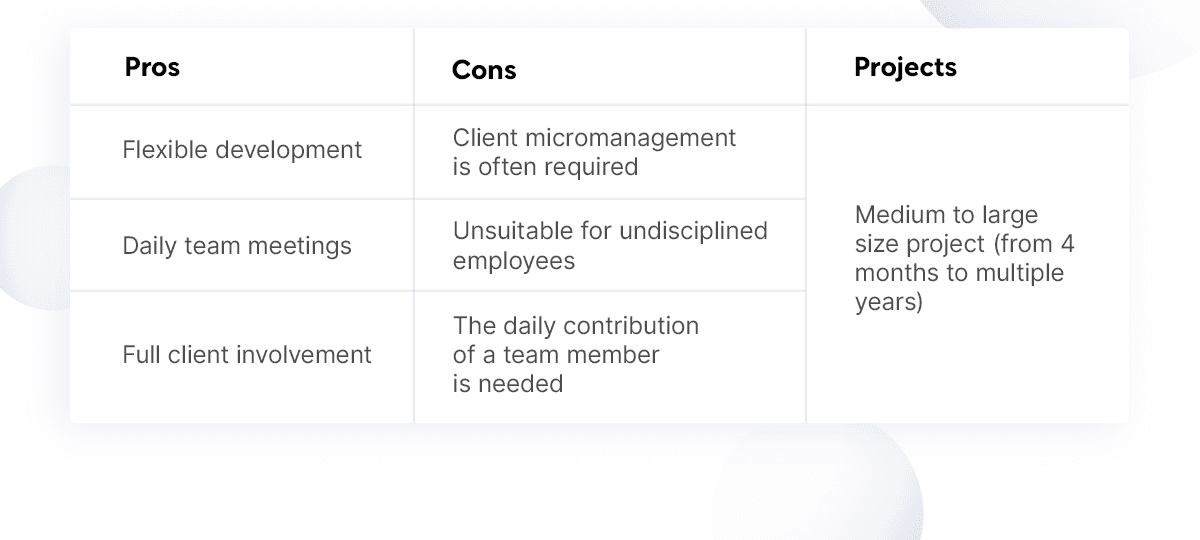

Scrum methodology
Mixed product development methodology
At RewiSoft, we can offer our customers mixed product development methodologies. For example, we can work with a mix of Scrum and Agile software development methodologies, dividing the project’s scope of work into sprints that last two weeks. This usually works best for small projects with tight deadlines and without project planning.
The pros and cons of mixed product development methodology and the projects that this model works best:
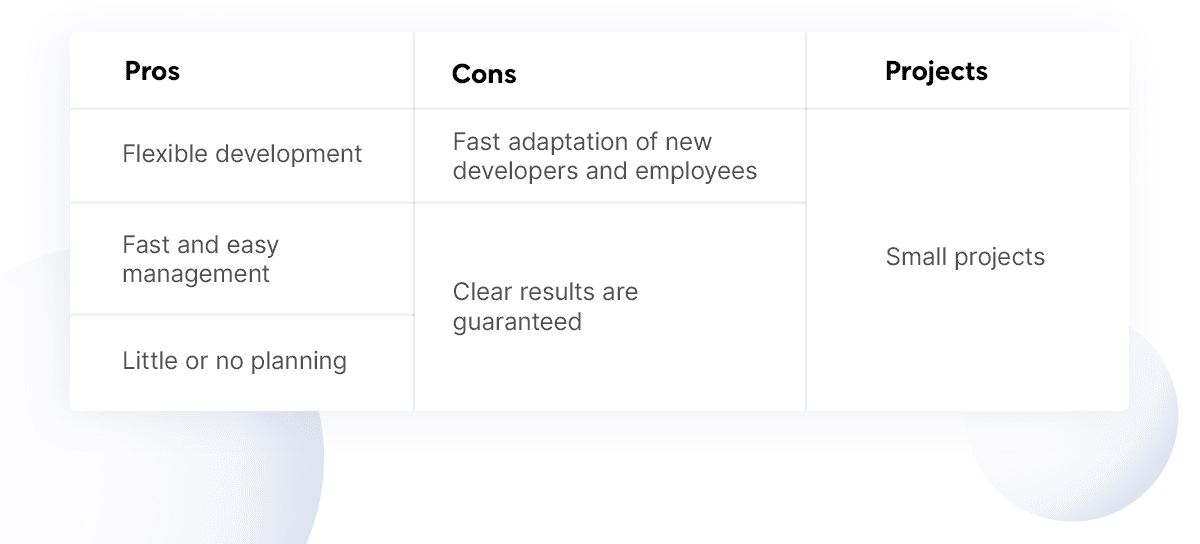

Mixed product development methodology
As you can conclude, the choice of a particular software development methodology can be mixed upon request and depend on various aspects: your basic needs, project size, preferred management style, etc.
Tasks You Need to Do Before Initiating Software Product Development
Before you decide to start planning your product development process, you need to complete a number of tasks to ensure an efficient and result-oriented approach.
Consider a collaboration model for your project
RewiSoft offers customers two collaboration models: product development outsourcing and IT staff augmentation.
Staff augmentation is a form of outsourcing model that allows you to maximize the efficiency of your in-house team. In other words, you invite your outsourcing vendor’s software team for how long you need to develop a solution or product. The primary responsibility is placed on the customer. It means you assign a manager from your in-house or remote team to manage the workflows and the overall development process.
Product development outsourcing is a project-based development approach where the primary responsibility is placed on your outsourcing provider. The outsourcing vendor is responsible for product development and management from initial ideation to final product launch.
There are also pricing contacts for software development outsourcing: time and materials, fixed price, and a dedicated software development team.
Depending on the requirements of your specific project, you should decide on the collaboration model that will work best to achieve product success.
Choose your development approach
As we mentioned earlier, choosing the development methodology will sketch the specifics of your process. In this way, you will outline key aspects of your project:
- Project duration
- Project scope
- Involvement in the development process
- Payment model
- Work schedule
Select collaboration software tools
It would help if you decided on collaboration software tools to successfully manage the development team and guide the overall product development. With the help of online tools, you’ll be able to monitor the process and understand the current development agenda at any time. Examples of such tools are:
- Project management tool (Jira, Trello)
- Task management tool (ClickUp)
- Digital visualization tool (Figma, Moqups, InVision)
- Communication tools (Slack, Skype, Google Hangouts)
- Developer tools (GitHub, Bitbucket)
Clarify roles and responsibilities, and form a team
The project’s team set is a list of experts needed to complete the tasks associated with product development. Depending on your project specifics, the team structure may rotate. Typically, to develop a product from scratch, there is a need for such specialists:
- Project manager
- Business analyst
- UX/UI designers
- Backend developer
- Frontend developer
- QA specialist
- DevOps
However, depending on the project you’re working on – other specialists and roles may be required. During project planning, you’ll be able to understand what specialists you need.
Software Product Development Challenges and RewiSoft Solutions
Let’s review the most common mistakes you may encounter when developing a software product and look at workable solutions for each case.
Wrong choice of technology
Problem: Wrong technology choice is a misstep causing project overtime and budget overheads. Chasing after brand-new technologies without specific experience using them increases the risks of unsuccessful product deployment.
Solution: To select the best technology suitable to unique product requirements, it’s best to:
- Identify the users’ pain points and problems you’re going to solve while creating a software product
- Assess the product’s functionality required
- Check the developers’ experience using them
- Hire professional experts to help you save your time and efforts in advance
Lack of focus on UX/UI
Problem: As we already mentioned, the UX/UI stage is critical before implementation. Without product design solutions, you risk getting a poor user experience and product malfunctions.
Solution: To avoid losing a good company’s reputation, ensure you’ve invested enough time and conduct design workshops to fulfill the product’s needs.
Software developers and engineers shortage
Problem: Despite your company’s size, you may lack sufficient resources to take up operational and development tasks.
The reasons are: high salaries, onshore talent shortage, and lack of time and finances for long-term onboarding and recruiting.
Solution: Don’t hesitate to outsource the software development team worldwide. Many Eastern Europe countries offer various end-to-end services, skillful teams, transparent project management workflows, and more. Are you interested to know the details? Find helpful information in our recent blog post on Eastern Europe software development outsourcing.
Long release cycle
Problem: Long release cycles can indicate an inefficient project management approach, the wrong team, development approach, or the wrong product focus. This can lead to a long time to market and an unpredictable software development process.
Solution: Ensure you’ve picked the suitable software product development methodology and thoroughly plan your product roadmap. Otherwise, reread our software development process and ask us any questions.
Team management blunders
Problem: Team management is a difficult task for specialists without relevant experience. A manager should track the developers’ work, ensuring the proper activity and the absence of blockers. If you don’t have an appropriate communications plan in place and the development team isn’t delivering what you expect, fix it.
Solution: Agile and Scrum development methodologies are reasonable solutions to detect any bottlenecks and eliminate them timely. In this way, you’ll be able to track the team’s success and deliver expected results.
Where to Hire a Software Product Development Team?
There are many ways to find the perfect match from the huge pool of talented software developers out there. Let’s discuss them in detail.
B2B directories
Well-known platforms that you can trust to find reliable software providers are Clutch and GoodFirms. These B2B directories allow companies to explore software services provided by companies from all over the world. You can filter your search, view portfolios and testimonials from real clients, and check the quality-to-value ratio of a software service provider.
Freelance online platforms
There are many freelance online platforms where you can find a potential candidate.
For example,
- Upwork – is a freelance website that connects software businesses and talents to collaborate on projects of all sizes
- TopTal, Guru – is a freelance website that links businesses to their recruitment needs
- LinkedIn – is a dedicated platform for hiring individual IT specialists and software companies where you can read reviews from real clients, evaluate portfolios and profiles of companies
- Glassdoor – is a dedicated platform for hiring individual IT specialists and software companies where you can read anonymous reviews from the company’s customers and employees
However, there are many risks associated with proper project commitment and quality of the rendered services.
Unfortunately, there are no specific mechanisms to help insure the freelance type of cooperation, unless you have a colleague’s recommendation or legal agreement.
Referrals
Searching for referrals is suitable for businesses with a vast professional network. You may know people in your industry who can recommend a particular software provider or individual IT specialist.
However, this option can also be time-consuming and risky. Moreover, if you don’t have such valuable business contacts, you may need time to make partnerships and find a suitable recommendation.
How to Develop a Software Product and Not Lose a Lot of Money?
The cost of creating a software product depends on many factors:
- Business model
- Features package
- Expected time to market
- Development approach
- Team location
- Team size
- Team expertise
- Hiring model
However, we’ve prepared a comparison table to help you understand the costs for software product development divided by the outsourcing region and project stage:
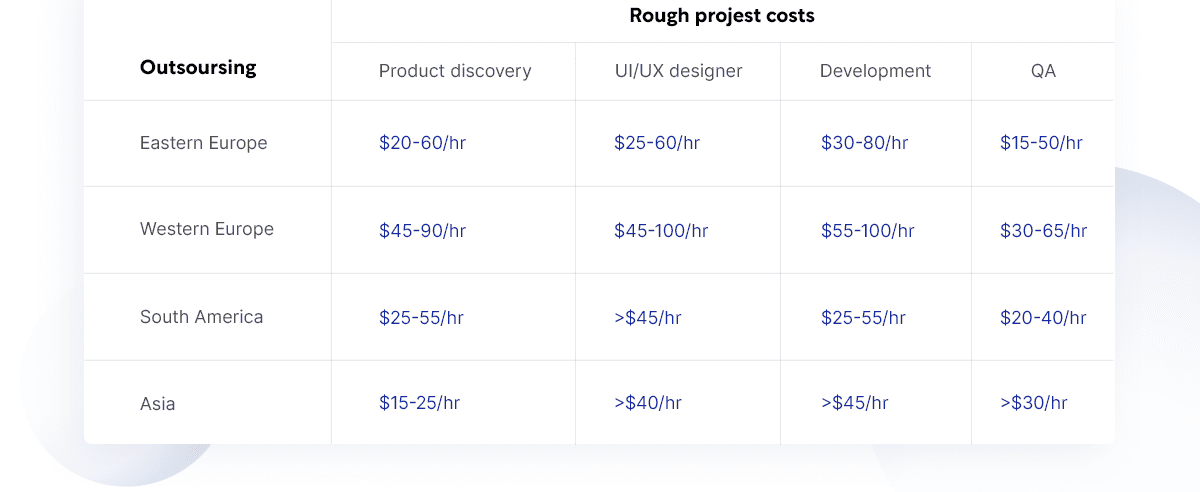

Rough project costs
How Much Time Does Software Product Development Take?
The time you need for software product development depends on factors such as:
- Project complexity
- Quantity and complexity of functionality
- Design complexity
- Expertise and experience of the team
- Selected tech stack
- Chosen development methodology
Regardless of your business request, you can always ask our sales managers to do this work for you. Share with us your project needs, and we will contact you as soon as possible.
Software Product Development: Conclusion
The key aspects and nгances highlighted above are a quick demo you need to learn before jumping into software product development. Getting real value from investing in software development is possible through efficient workflow organization, tracking, and management.
With the help of a talented team, you will be able to maximize the desired outcome while minimizing the risks of product failure.
The RewiSoft team has a mature product development workflow, multiple collaboration models, and knowledge of the best technologies used to develop a variety of software products. Contact us to benefit from our team firsthand!







